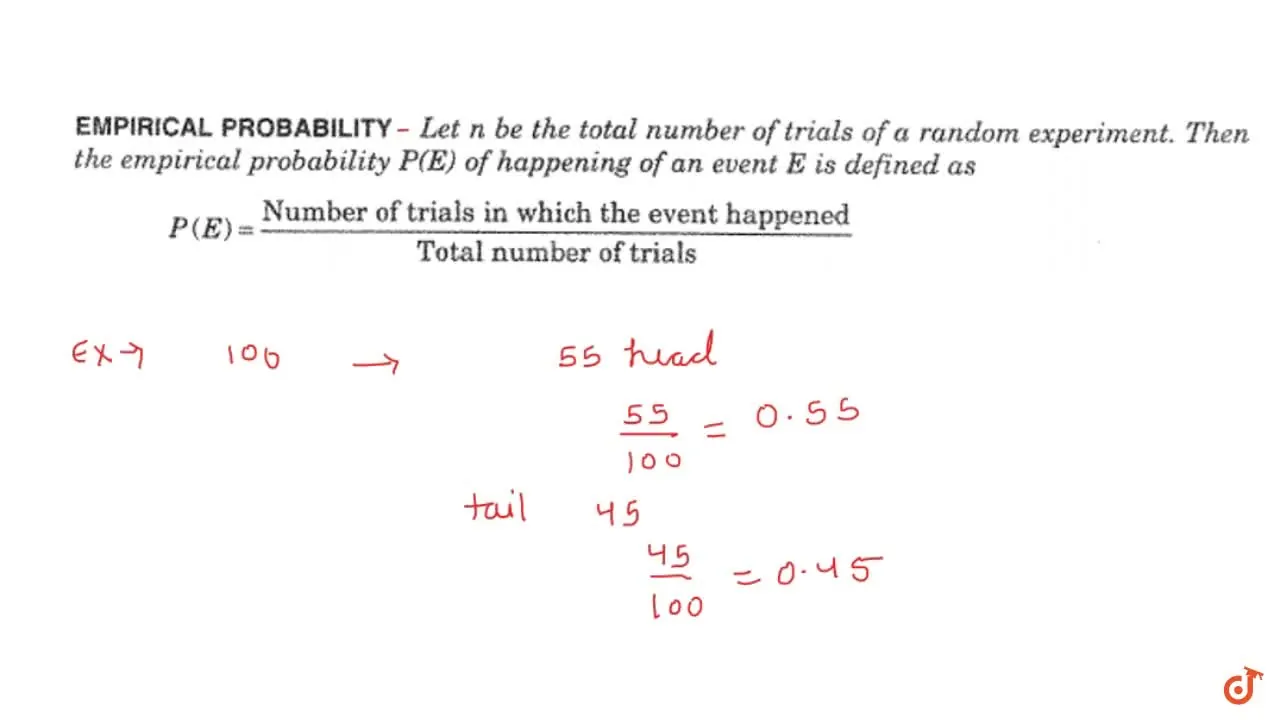Empirical probability
Empirical Probability
Empirical probability is the general recurrence of the event of an occasion and is dictated by observation of an experiment. Think about a test, occasion A happens "f" number of times in the event that we repeat test n times.
Then f/m is known as frequency ratio. The limiting value from the frequency ratio as the number of repetitions becomes infinitely large is known as probability of the given event.
At that point f/n is known as recurrence ratio. The limiting an incentive from the recurrence ratio as the quantity of redundancies turns out to be vastly huge is known as probability of the given occasion.
Probability is partitioned into two sections: theoretical probability and empirical probability. Now and again empirical probability named as experimental probability. The probability of an event will consistently be a number somewhere in the range of zero and one. An empirical probability of zero (0) implies that the event never happened and one (1) implies that the event consistently happened. Right now learn about empirical probability equation in detail.
Empirical probability of an event is a measure that the event will happen dependent on test information of performing repeated trials of a probability experiment. The empirical way to deal with probability depends on law of large numbers. So to accomplish more precision in the outcome, gather more perceptions which give progressively precise estimate of the probability.
Empirical probability = Probability of an event taking place is the ratio of the time similar events occurred in the past.
or Empirical probability = Number of times event happens/Total number of times experiment performed
Solved Examples on Empirical Probability
Q 1: Total eight coins are tossed. Frequencies of the number of tails appeared are mentioned below.
X
0
1
2
3
4
5
6
7
8
F
2
15
29
57
70
59
20
10
8
Determine the probability of tails:
i) Less than 4
ii) Equal to 5
iii) More than 6
Sol:
Total number of heads occurred in an experiment = 2 + 15 + 29 + 57 + 70 + 59 + 20 + 10 + 8 = 270
i) P(occurred tails less than 4)
From given table, number of favorable cases = 2 + 15 + 29 + 57 = 103
Therefore P(tails less than 4) = 103/270 = 0.38
ii) P( occurred tails equal to 5).
From given table, number of required cases = 59
Therefore P( tails equal to 5) = 59/270 = 0.22
iii) P( more than 6 tails)
Total number of cases = 18
So P(tails more than 6) = 18/270 = 0.07
Q 2: A coin is tossed 100 times out of which head comes 12 times. Find the experimental probability of getting a head?
Sol:
The coin is tossed100 times. So total number of trails =100
The number of times the required event occurs = 12
Therefore probability of getting the event of head =12/100 = 0.12
Q 3: The marks obtained by 1200 students in a particular examination are tabulated below.
Marks
100-120
120-140
140-160
160-180
180-200
No. of Students
63
142
500
320
175
Determine the probability that a student selected has marks :
i) Between 140 and 200
ii) Above 180
iii) Under 140
Sol:
Total marks obtained by students = 63 + 142 + 500 + 320 + 175 = 1200
i) Probability that a selected student obtain marks under 140.
Total students, 142 + 63 = 205 students.
∴ P(student scored marks under 140)= 205/1200 = 0.17
ii) Probability that a selected student get marks between 140 and 200.
There are 500 + 320 + 175 = 995 students.
∴ P(student scored marks between 140 and 200) = 995/1200 = 0.83
iii) Probability that a selected student obtain marks above 180.
There are 175 students.
∴ P(student scored marks above 180) = 75/1200 = 0.15
Probability is partitioned into two sections: theoretical probability and empirical probability. Now and again empirical probability named as experimental probability. The probability of an event will consistently be a number somewhere in the range of zero and one. An empirical probability of zero (0) implies that the event never happened and one (1) implies that the event consistently happened. Right now learn about empirical probability equation in detail.
or Empirical probability = Number of times event happens/Total number of times experiment performed
X
0
1
2
3
4
5
6
7
8
F
2
15
29
57
70
59
20
10
8
Determine the probability of tails:
i) Less than 4
ii) Equal to 5
iii) More than 6
Sol:
Total number of heads occurred in an experiment = 2 + 15 + 29 + 57 + 70 + 59 + 20 + 10 + 8 = 270
i) P(occurred tails less than 4)
From given table, number of favorable cases = 2 + 15 + 29 + 57 = 103
Therefore P(tails less than 4) = 103/270 = 0.38
ii) P( occurred tails equal to 5).
From given table, number of required cases = 59
Therefore P( tails equal to 5) = 59/270 = 0.22
Total number of cases = 18
So P(tails more than 6) = 18/270 = 0.07
Sol:
The coin is tossed100 times. So total number of trails =100
The number of times the required event occurs = 12
Therefore probability of getting the event of head =12/100 = 0.12
Q 3: The marks obtained by 1200 students in a particular examination are tabulated below.
Marks
100-120
120-140
140-160
160-180
180-200
No. of Students
63
142
500
320
175
Determine the probability that a student selected has marks :
i) Between 140 and 200
ii) Above 180
iii) Under 140
Sol:
Total marks obtained by students = 63 + 142 + 500 + 320 + 175 = 1200
i) Probability that a selected student obtain marks under 140.
Total students, 142 + 63 = 205 students.
∴ P(student scored marks under 140)= 205/1200 = 0.17
ii) Probability that a selected student get marks between 140 and 200.
There are 500 + 320 + 175 = 995 students.
∴ P(student scored marks between 140 and 200) = 995/1200 = 0.83
iii) Probability that a selected student obtain marks above 180.
There are 175 students.
∴ P(student scored marks above 180) = 75/1200 = 0.15
Similar Questions
Experimental (Or Empirical) Probabilities|Probability - A Theoretical Approach|Random Experiment|Equally Likely Out-Comes|Not Equally Likely Out-Comes|Questions|Event|Question|OMR
View SolutionEmpirically verifiable observations are called as
View SolutionLaws OF chemical Combination || Empirical and Molecular Formula || Determination OF Empirical formula from Combustion Data || Laws OF chemical Combination || Empirical and Molecular Formula || Determination OF Empirical formula from Combustion Data
View SolutionEmpirical And Molecular Formula Calculations
View SolutionEmpirical formula of glucose is ____________
View SolutionEmpirical formula of Hydrogen Peroxide is-
View SolutionEmpirical formula of Ethane' is
View SolutionEmpirical formula of Benzene is -
View SolutionEmpirical formula of glucose is
View SolutionThe empirical formula of hydrogen peroxide is……………….
View Solution


